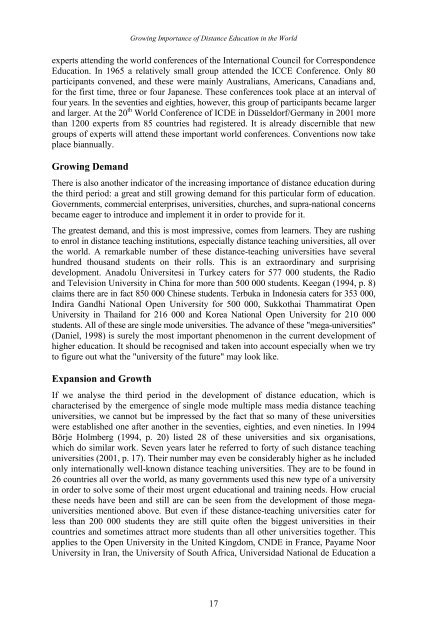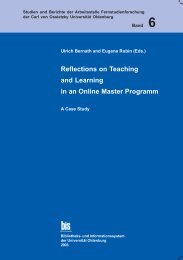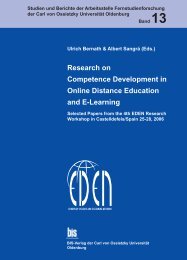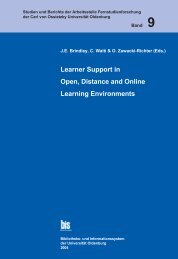Distance Education in Transition - Master of Distance Education ...
Distance Education in Transition - Master of Distance Education ...
Distance Education in Transition - Master of Distance Education ...
You also want an ePaper? Increase the reach of your titles
YUMPU automatically turns print PDFs into web optimized ePapers that Google loves.
Grow<strong>in</strong>g Importance <strong>of</strong> <strong>Distance</strong> <strong>Education</strong> <strong>in</strong> the World<br />
experts attend<strong>in</strong>g the world conferences <strong>of</strong> the International Council for Correspondence<br />
<strong>Education</strong>. In 1965 a relatively small group attended the ICCE Conference. Only 80<br />
participants convened, and these were ma<strong>in</strong>ly Australians, Americans, Canadians and,<br />
for the first time, three or four Japanese. These conferences took place at an <strong>in</strong>terval <strong>of</strong><br />
four years. In the seventies and eighties, however, this group <strong>of</strong> participants became larger<br />
and larger. At the 20 th World Conference <strong>of</strong> ICDE <strong>in</strong> Düsseldorf/Germany <strong>in</strong> 2001 more<br />
than 1200 experts from 85 countries had registered. It is already discernible that new<br />
groups <strong>of</strong> experts will attend these important world conferences. Conventions now take<br />
place biannually.<br />
Grow<strong>in</strong>g Demand<br />
There is also another <strong>in</strong>dicator <strong>of</strong> the <strong>in</strong>creas<strong>in</strong>g importance <strong>of</strong> distance education dur<strong>in</strong>g<br />
the third period: a great and still grow<strong>in</strong>g demand for this particular form <strong>of</strong> education.<br />
Governments, commercial enterprises, universities, churches, and supra-national concerns<br />
became eager to <strong>in</strong>troduce and implement it <strong>in</strong> order to provide for it.<br />
The greatest demand, and this is most impressive, comes from learners. They are rush<strong>in</strong>g<br />
to enrol <strong>in</strong> distance teach<strong>in</strong>g <strong>in</strong>stitutions, especially distance teach<strong>in</strong>g universities, all over<br />
the world. A remarkable number <strong>of</strong> these distance-teach<strong>in</strong>g universities have several<br />
hundred thousand students on their rolls. This is an extraord<strong>in</strong>ary and surpris<strong>in</strong>g<br />
development. Anadolu Üniversitesi <strong>in</strong> Turkey caters for 577 000 students, the Radio<br />
and Television University <strong>in</strong> Ch<strong>in</strong>a for more than 500 000 students. Keegan (1994, p. 8)<br />
claims there are <strong>in</strong> fact 850 000 Ch<strong>in</strong>ese students. Terbuka <strong>in</strong> Indonesia caters for 353 000,<br />
Indira Gandhi National Open University for 500 000, Sukkothai Thammatirat Open<br />
University <strong>in</strong> Thailand for 216 000 and Korea National Open University for 210 000<br />
students. All <strong>of</strong> these are s<strong>in</strong>gle mode universities. The advance <strong>of</strong> these "mega-universities"<br />
(Daniel, 1998) is surely the most important phenomenon <strong>in</strong> the current development <strong>of</strong><br />
higher education. It should be recognised and taken <strong>in</strong>to account especially when we try<br />
to figure out what the "university <strong>of</strong> the future" may look like.<br />
Expansion and Growth<br />
If we analyse the third period <strong>in</strong> the development <strong>of</strong> distance education, which is<br />
characterised by the emergence <strong>of</strong> s<strong>in</strong>gle mode multiple mass media distance teach<strong>in</strong>g<br />
universities, we cannot but be impressed by the fact that so many <strong>of</strong> these universities<br />
were established one after another <strong>in</strong> the seventies, eighties, and even n<strong>in</strong>eties. In 1994<br />
Börje Holmberg (1994, p. 20) listed 28 <strong>of</strong> these universities and six organisations,<br />
which do similar work. Seven years later he referred to forty <strong>of</strong> such distance teach<strong>in</strong>g<br />
universities (2001, p. 17). Their number may even be considerably higher as he <strong>in</strong>cluded<br />
only <strong>in</strong>ternationally well-known distance teach<strong>in</strong>g universities. They are to be found <strong>in</strong><br />
26 countries all over the world, as many governments used this new type <strong>of</strong> a university<br />
<strong>in</strong> order to solve some <strong>of</strong> their most urgent educational and tra<strong>in</strong><strong>in</strong>g needs. How crucial<br />
these needs have been and still are can be seen from the development <strong>of</strong> those megauniversities<br />
mentioned above. But even if these distance-teach<strong>in</strong>g universities cater for<br />
less than 200 000 students they are still quite <strong>of</strong>ten the biggest universities <strong>in</strong> their<br />
countries and sometimes attract more students than all other universities together. This<br />
applies to the Open University <strong>in</strong> the United K<strong>in</strong>gdom, CNDE <strong>in</strong> France, Payame Noor<br />
University <strong>in</strong> Iran, the University <strong>of</strong> South Africa, Universidad National de <strong>Education</strong> a<br />
17





